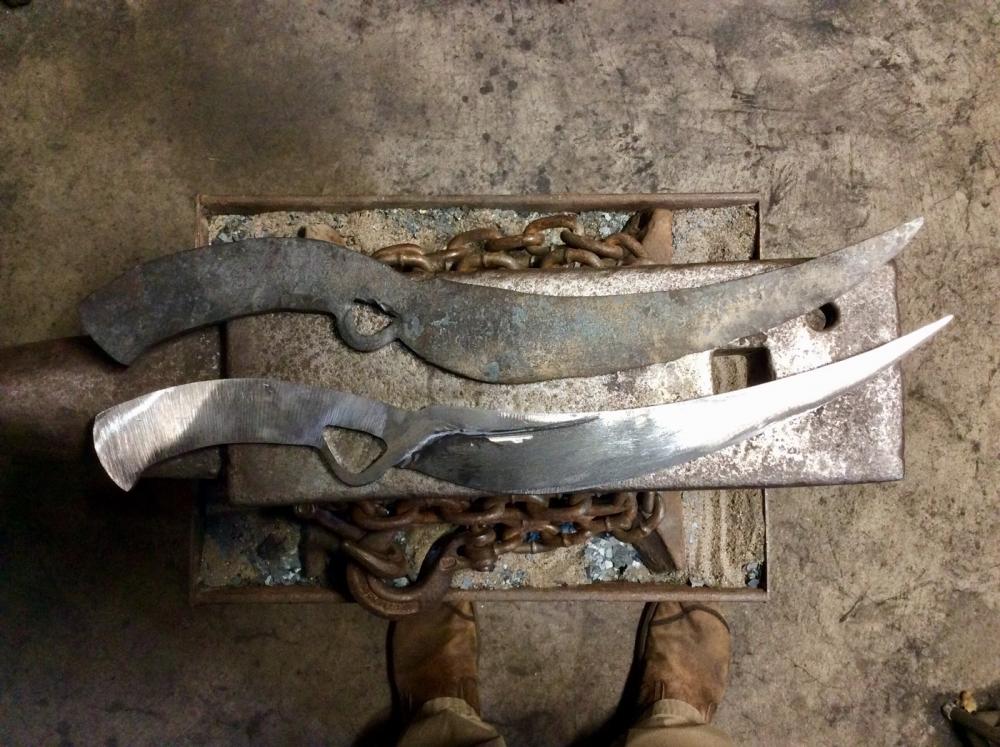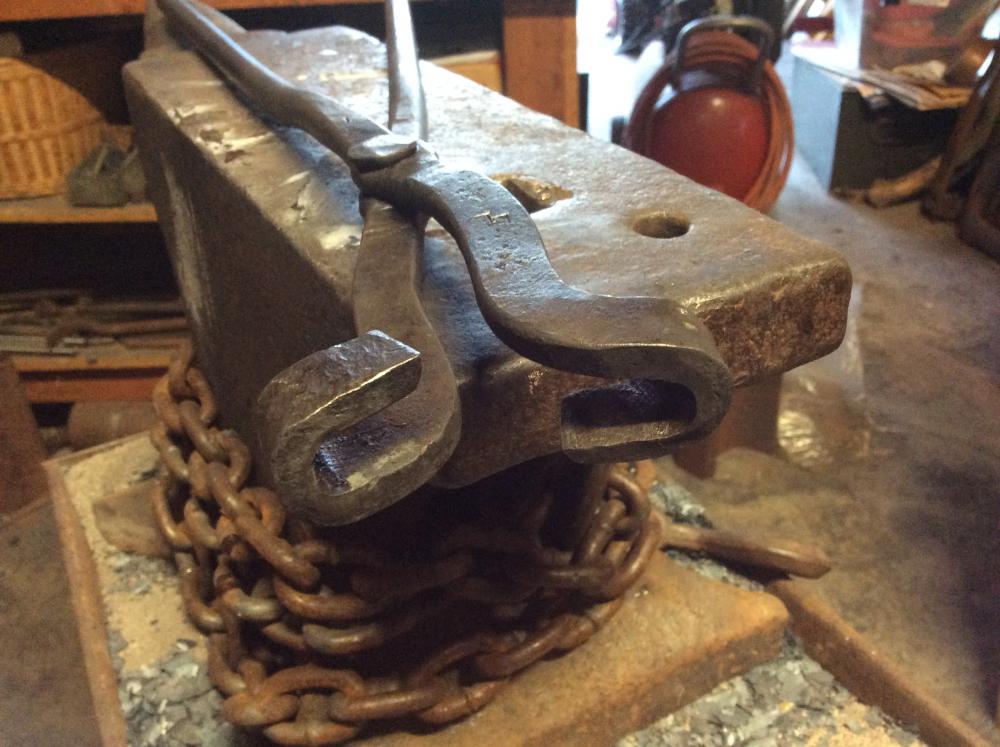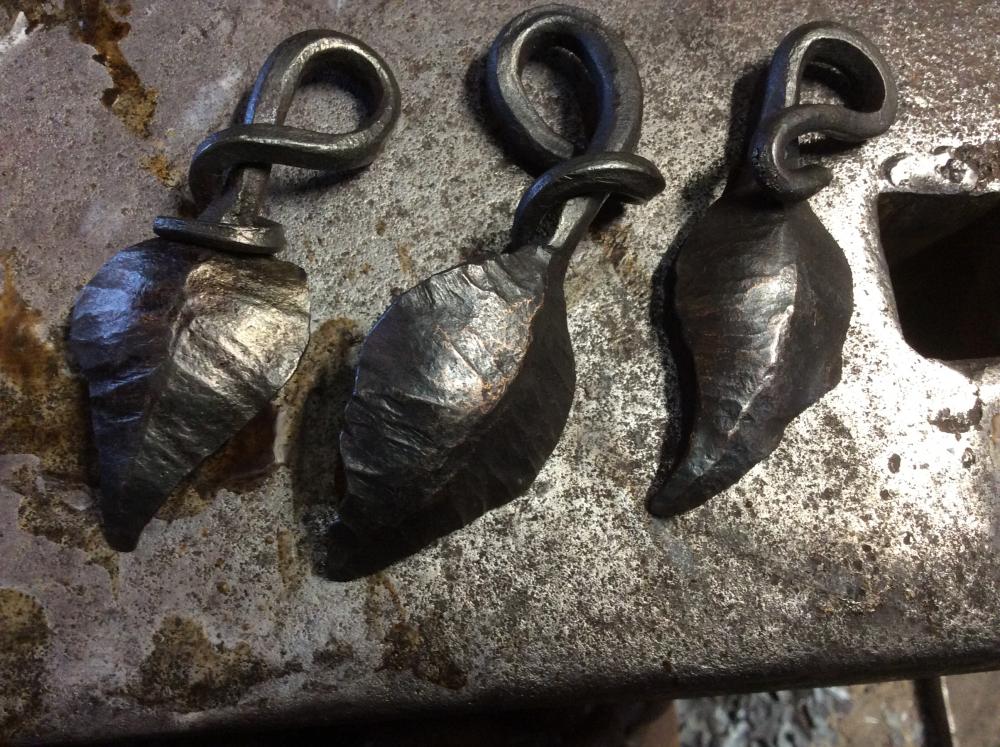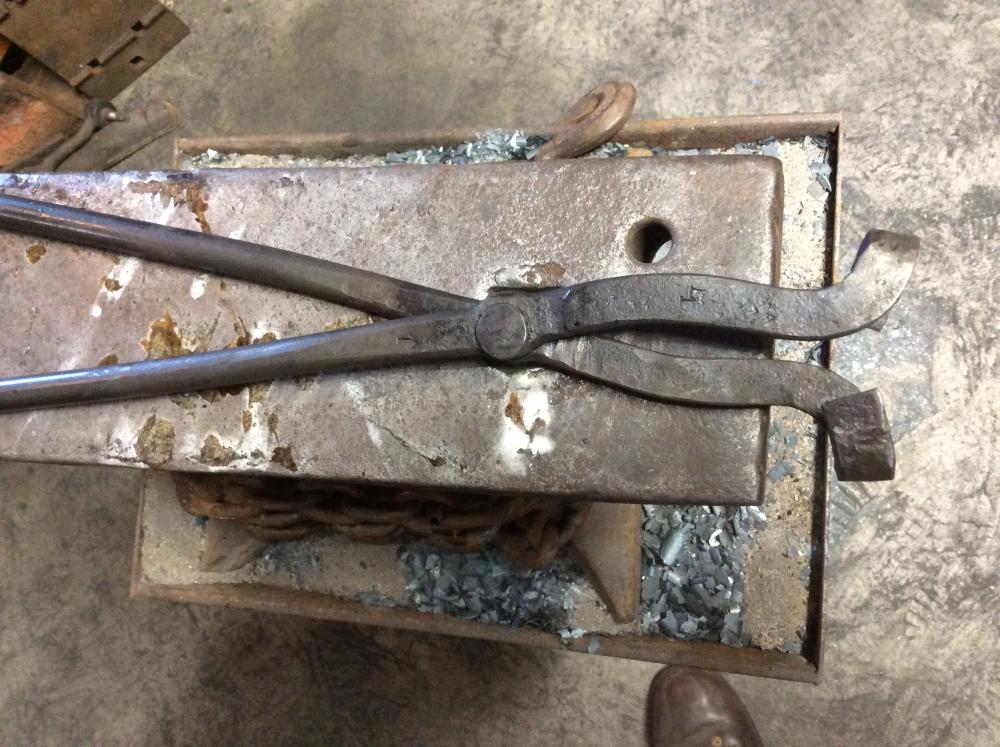-
Posts
1,180 -
Joined
-
Last visited
Content Type
Profiles
Forums
Articles
Gallery
Downloads
Events
Everything posted by Lou L
-
jlpservicesinc taught me a way to clean mild steel on the inside folds of the billet where nothing can reach (so the forge weld is clean). It was amazingly simple! She heated the piece to light red and plunged it in the water. The reaction blows the scale off the piece. She then immediately pulled it out, put it on the anvil, and tapped it lightly with a hammer. I watched the final tiny pieces of scale fall off leaving a nice clean layer of metal. The forge weld went perfectly. Im not sure if this is possible for your piece but, if there is heavy scale, it will do a lot of the work for you. I’ve never tried the chemical methods but the above posters know a lot more than I do. Lou
-
You can get yourself a small bounce house blower. They sell small, 1/8 and 1/6 horsepower blowers for small yard inflatables that are very quiet and produce excellent volume and pressure. I believe mine is from the brand Xpower. It is all black. It was rather cheap for something so quiet and effective.
-
MastaStan, I am a Newb for sure! And this knife is beyond newb level...but I’m well read, I listen to my superiors, and I’m dedicated to a slow, thoughtful process. Therefore, I have a snowball’s chance. I hope I’m able to produce something interesting. Thomas Powers, You are dead right, that knife would have no place in the SCA. I wasn’t even thinking about making something period. Either my buddy had no intention for it to be an SCA prop or his imagination got the best of him. I honestly didn’t ask. I just accepted his challenge.
-

What did you do in the shop today?
Lou L replied to Mark Ling's topic in Blacksmithing, General Discussion
Well, I haven’t even heat treated the first of four knives. I have been creeping slowly through the first to get information (there was actually another that offered a serious lesson about heat management when drifting the finger hole). When I was confident with the potential of the first I rough forged number 2. I’m basically at the start of this! If I need help and have the day to set aside I will definitely beg your aid! Thanks so much for the offer. -

What did you do in the shop today?
Lou L replied to Mark Ling's topic in Blacksmithing, General Discussion
Oh! And I should align the blade with the North Pole too, right? Nice wall hanger, Viking! -
Thanks for the input all! I have no idea what my buddy intends to do with the knives beside give them as gifts. I am quite certain that all the people receiving one are active in the SCA and the knives are likely to be gear at Pennsic. Perhaps they will only be ornamental...who knows? I love the idea of using brass or bronze for the raised area. It would make the grinding magnitudes easier but adds the complexity of the brass work. I don’t have a clue as to which brass is workable and otherwise suited to the task. Perhaps I’ll PM Theo if this first one doesn’t work out. I will be certain to give it a few thermal cycles prior to the quench. It is entirely likely that, in my ignorance and haste, I might have skipped that step. Does anyone have any suggestions for removing the crud and scale after the heat treat?
-

What did you do in the shop today?
Lou L replied to Mark Ling's topic in Blacksmithing, General Discussion
I posted my request for succor in the knife making section. I begged for more insight into the vertical vs. horizontal quench mainly because I don’t want to have to find a new container -
Okay, here is my latest project! My old friend is a unique individual and asked me if I could make knives for him to give away to the three people standing up for him at his wedding...and one for him. I told him I would give it a go and reinforced all the realities of my incompetence in the knife making realm. He sent me a design he wanted and asked me to make them as big as possible within the limits of my equipment and ability. Here is his design. He wasn’t certain how he expected me to get those shapes around the spine and ricasso..he just liked the design. I decided to keep it thick at the spine and grind the blade thinner below it...if that makes sense. Here are my first two attempts at various stages. One is the very rough forging, the other is ground and needing a few refinements before quenching. Both are about 17” and are forged out of leaf spring stock. Questions to follow: So, the thickness of the blade tapers significantly toward the tip (distal taper) and the thick part of the spine is much thicker than the blade below it. My concern is the quench. I intend to quench in heated peanut oil. My current quench tank is a large, horizontal ammo can. I fully expect the blade to warp like mad. It has been annealed correctly (heated just past non magnetic and cooled slowly in very fine ash overnight) twice. Questions: Am I completely doomed if I quench it horizontally? How thin is too thin for the blade prior to quenching? I went pretty thin at the very end of the taper because I feared destroying the temp trying to remove too much near the tip later on. What grit finish should I have on it before heat treat? Why did I tell my friend I would do this for him? Thanks for reading and more thanks for your help, Lou
-

What did you do in the shop today?
Lou L replied to Mark Ling's topic in Blacksmithing, General Discussion
Very cool! I’m still working on knives (never thought I would say that). I just have to post the San mai taco jlpservicesinc made for me. The cold shut is epic and requires a complete re-envisioning of the blade. The other blades are requests froma good friend and are seriously challenging. I have to destroy the first one in the heat treat soon! I think I’ll post a request for input before I take the plunge. -
Yep, beautiful anvil that is. I would make one correction to what you said though. It was not from a collector hoard. It was from a “failed collector hoard”. Because, seriously, what collector would release that beauty?
-
Thanks for sharing the journey. That hammer is stunning. I haven’t seen you on YouTube in a while. Did you start a new channel?
-
JHCC and I just had a go with this recently. My suggestion would be this: When it comes time to flatten the section of stock you isolated to form the leaf don’t flatten it outright. Just give it a light tap or two to create a small flat area and then get to work with a straight peen or cross peen. Spread it sideways a bit and then rotate the peen sideways to push material out into those corners. A rounding hammer will set you back as it will send material in all directions. You could also try upsetting the end of your stock a bit before your set down to isolate the leaf material. That might give you more to work with. Even still, only the straight peen will give you what you want. Ball peen bad! I’ve gotten into making leaves since JHCC’s visit because it is great for hammer control practice....which I need... edited to add: I looked back at the picture and you can see the lines from the peening hammer on the leaf. They clearly show how the smith turned the hammer to direct the material. Lou
-
I have two creatures that wander into my shop area on occasion. They are not yet house broken and so I try to keep them out of the shop. I wouldn't say they are loyal but they sure do appreciate treats.
-
Thanks! I seriously didn’t expect that complete of an answer. I figured that some disfiguring would happen and wondered if the cost benefit was there. I’m certain I would have tried the convenience bend and suffered mightily to turn my egg back into a heart. Ive heard two things...I think: 1. Forge with patience and keep it simple stupid. 2. You won’t really know until you do it yourself...so go do it...stupid Seriously, thanks for all the time you put into your response. Lou
-
Beautiful anvil. If the deal was too good please don’t tell me...otherwise I’m curious.
-
SHVTZHOT, you have warmed the hearts of all IFI members. I’ve lost count of the number of times experienced members have done backflips trying to convince new members to not abuse their anvils by attempting to grind or weld the precious steel face. Well done!
-
I know more about the surface of the moon than I do about gassers. That said, are you planning on hinging a door to one of the bolts near the front! I know it will help with efficiency. From what I have read here in the past, I am pretty certain the experienced gas forge guys here tell people to stay away from brick only forges for long term use. Efficiency and durability are their issues I believe. Still, it’s a great way to get up and running in my opinion. Still, you should look into castable refractory and/or ceramic blanket for the top and sides as you move forward. There are a few must read threads that are stickied in the gas forge section that tell all. Either way, I say you fire it up and mash some metal while you think on it. Lou
-
Hey, welcome aboard! Nice job on your first projects. The nibs on those tongs are a little bent but, guess what...you are now a blacksmith and can shape them to suit your needs! It looks like you have enough meat on them to add grooves for holding square or round stock. I say it like it’s nothing but, in reality, I seem to have a harder time doing that than making the rest of a tong.... Also, look up NEB (New England Blacksmiths chapter of ABANA). I’ll beat Judson to the punch and suggest you join us. The organization has been growing a lot lately. http://www.newenglandblacksmiths.org/ Bonus for you: You are much closer to the Brentwood Teaching Facility and can go there for monthly hammer-ins and basically get free lessons/experience I dream of. Lou
-
Charles, I’ve considered playing with an old radiator as well. I’m not certain if the temperature difference in the water would be enough to circulate the water through all that interior volume. And once it all gets hot you may lose circulation. Still, I want to try it. I currently use a self made water cooled tuyere. I do enjoy that it is “plug and play”. Combined with an electric blower and an air gate my forge basically just goes as long as I want to use it. My design is definitely a work in progress; but, I think that a more experienced smith who knows how they want all the other aspects of their forge to be will enjoy the addition. I have had my bosh freeze solid in the winter but I was lucky, I guess, and the expanding ice had room to expand without breaking welds. Rust, I am certain, will lead to the demise of my bosh in short order. I’m looking for a stainless steel alternative. I have an old stainless steel double kitchen sink that is tempting me. I’m also wondering if any of those sprayable rubber sealers are able to tolerate boiling water temperature. However, the water in my bosh has never boiled, even when it is very low. In fact, I never keep it full anymore. Lou
-

What did you do in the shop today?
Lou L replied to Mark Ling's topic in Blacksmithing, General Discussion
Let’s not reenact a scene from Star Wars. I like to keep my nerd card deep in my wallet. -

What did you do in the shop today?
Lou L replied to Mark Ling's topic in Blacksmithing, General Discussion
For sure. I started it but was not happy with my tong options. It was hard to control and made me slower and less accurate. I expect to be grinding that knife soon..perhaps tomorrow. I need to get some grinding experience u dear my belt because a friend has requested some complex knives from me and I am currently unequipped to make them. -

What did you do in the shop today?
Lou L replied to Mark Ling's topic in Blacksmithing, General Discussion
I had a good time in the shop today. I decided to work on the leaf technique I recently learned from @JHCC so I made a few keychain jinglies my wife and mother requested. Then I sized and fit up the tongs I made for flat stock/knife making. Got some beeswax on the anvil...it’s not rust. -
I think it would have to have a one inch hardy hole and a two inch hole for drifting hammers and such as well as for making hardy tools. Also, I think,it would be useful for two of the corners to be rounded with different radiuses for sheet metal or armor making. The dishing areas for spoons and bowls are super nice as well. Lou
-

Rail - evidence of heat treat?
Lou L replied to Michael Cochran's topic in Heat Treating, general discussion
I have no direct knowledge but a little searching revealed to me that hardened rails do exist. The process is called head hardening. The hardened rails are more durable and are used in areas where particularly heavy trains travel or where there is a slow down zone. It seems they use a process of thermal cycling to achieve the hardness. I have absolutely no idea if that process would result in a thru-hardened rail or one hardened o lay to a certain depth. I would assume they would want a soft, squishy core for more toughness though. Oh, and when it comes to whiskey, I will choose a barrel strength rye every time. High West, James E. Pepper ....oh, the list is so long and glorious.






